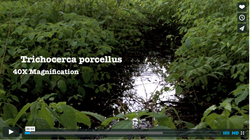
Trichocerca porcellus is a microorganism found in many ponds, rivers, and creeks. The name Trichocerca is derived from the Greek words thrix, meaning "hair," and kerkos, "tail." A distinguishing feature of Trichocerca porcellus is its hairlike spines.
We discovered this adorable microorganism while gathering field samples for our video archive. After observing the rhythms and movements of our curious little Tricocerca: "Toby," I was able to compose a score, which harmonized well with his meticulous gestures.
We discovered this adorable microorganism while gathering field samples for our video archive. After observing the rhythms and movements of our curious little Tricocerca: "Toby," I was able to compose a score, which harmonized well with his meticulous gestures.
 RSS Feed
RSS Feed